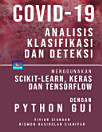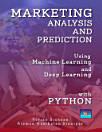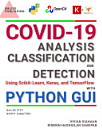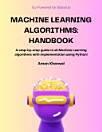EMOTION PREDICTION FROM TEXT USING MACHINE LEARNING AND DEEP LEARNING WITH PYTHON GUI
About this ebook
The book begins by highlighting the importance of emotion detection in various domains such as social media analysis, customer sentiment evaluation, and psychological research. Understanding human emotions in text is shown to have a profound impact on decision-making processes and enhancing user experiences.
Readers are then guided through the crucial stages of data preprocessing, where text is carefully cleaned, tokenized, and transformed into meaningful numerical representations using techniques like Count Vectorization, TF-IDF Vectorization, and Hashing Vectorization.
Traditional machine learning models, including Logistic Regression, Random Forest, XGBoost, LightGBM, and Convolutional Neural Network (CNN), are explored to provide a foundation for understanding the strengths and limitations of conventional approaches.
However, the focus of the book shifts towards the Long Short-Term Memory (LSTM) model, a powerful variant of recurrent neural networks. Leveraging word embeddings, the LSTM model adeptly captures semantic relationships and long-term dependencies present in text, showcasing its potential in emotion detection.
The LSTM model's exceptional performance is revealed, achieving an astounding accuracy of 86% on the test dataset. Its ability to grasp intricate emotional nuances ingrained in textual data is demonstrated, highlighting its effectiveness in capturing the rich tapestry of human emotions.
In addition to the LSTM model, the book also explores the Convolutional Neural Network (CNN) model, which exhibits promising results with an accuracy of 85% on the test dataset. The CNN model excels in capturing local patterns and relationships within the text, providing valuable insights into emotion detection.
To enhance usability, an intuitive training and predictive interface is developed, enabling users to train their own models on custom datasets and obtain real-time predictions for emotion detection. This interactive interface empowers users with flexibility and accessibility in utilizing the trained models.
The book further delves into the performance comparison between the LSTM model and traditional machine learning models, consistently showcasing the LSTM model's superiority in capturing complex emotional patterns and contextual cues within text data.
Future research directions are explored, including the integration of pre-trained language models such as BERT and GPT, ensemble techniques for further improvements, and the impact of different word embeddings on emotion detection. Practical applications of the developed system and models are discussed, ranging from sentiment analysis and social media monitoring to customer feedback analysis and psychological research. Accurate emotion detection unlocks valuable insights, empowering decision-making processes and fostering meaningful connections.
In conclusion, this project encapsulates a transformative expedition into understanding human emotions in text. By harnessing the power of machine learning techniques, the book unlocks the potential for accurate emotion detection, empowering industries to make data-driven decisions, foster connections, and enhance user experiences. This book serves as a beacon for researchers, practitioners, and enthusiasts venturing into the captivating world of emotion detection in text.
Ratings and reviews
About the author
Vivian Siahaan is a fast-learner who likes to do new things. She was born, raised in Hinalang Bagasan, Balige, on the banks of Lake Toba, and completed high school education from SMAN 1 Balige. She started herself learning Java, Android, JavaScript, CSS, C ++, Python, R, Visual Basic, Visual C #, MATLAB, Mathematica, PHP, JSP, MySQL, SQL Server, Oracle, Access, and other programming languages. She studied programming from scratch, starting with the most basic syntax and logic, by building several simple and applicable GUI applications. Animation and games are fields of programming that are interests that she always wants to develop. Besides studying mathematical logic and programming, the author also has the pleasure of reading novels. Vivian Siahaan has written dozens of ebooks that have been published on Sparta Publisher: Data Structure with Java; Java Programming: Cookbook; C ++ Programming: Cookbook; C Programming For High Schools / Vocational Schools and Students; Java Programming for SMA / SMK; Java Tutorial: GUI, Graphics and Animation; Visual Basic Programming: From A to Z; Java Programming for Animation and Games; C # Programming for SMA / SMK and Students; MATLAB For Students and Researchers; Graphics in JavaScript: Quick Learning Series; JavaScript Image Processing Methods: From A to Z; Java GUI Case Study: AWT & Swing; Basic CSS and JavaScript; PHP / MySQL Programming: Cookbook; Visual Basic: Cookbook; C ++ Programming for High Schools / Vocational Schools and Students; Concepts and Practices of C ++; PHP / MySQL For Students; C # Programming: From A to Z; Visual Basic for SMA / SMK and Students; C # .NET and SQL Server for High School / Vocational School and Students. At the ANDI Yogyakarta publisher, Vivian Siahaan also wrote a number of books including: Python Programming Theory and Practice; Python GUI Programming; Python GUI and Database; Build From Zero School Database Management System In Python / MySQL; Database Management System in Python / MySQL; Python / MySQL For Management Systems of Criminal Track Record Database; Java / MySQL For Management Systems of Criminal Track Records Database; Database and Cryptography Using Java / MySQL; Build From Zero School Database Management System With Java / MySQL.
Rismon Hasiholan Sianipar was born in Pematang Siantar, in 1994. After graduating from SMAN 3 Pematang Siantar 3, the writer traveled to the city of Jogjakarta. In 1998 and 2001 the author completed his Bachelor of Engineering (S.T) and Master of Engineering (M.T) education in the Electrical Engineering of Gadjah Mada University, under the guidance of Prof. Dr. Adhi Soesanto and Prof. Dr. Thomas Sri Widodo, focusing on research on non-stationary signals by analyzing their energy using time-frequency maps. Because of its non-stationary nature, the distribution of signal energy becomes very dynamic on a time-frequency map. By mapping the distribution of energy in the time-frequency field using discrete wavelet transformations, one can design non-linear filters so that they can analyze the pattern of the data contained in it. In 2003, the author received a Monbukagakusho scholarship from the Japanese Government. In 2005 and 2008, he completed his Master of Engineering (M.Eng) and Doctor of Engineering (Dr.Eng) education at Yamaguchi University, under the guidance of Prof. Dr. Hidetoshi Miike. Both the master's thesis and his doctoral thesis, R.H. Sianipar combines SR-FHN (Stochastic Resonance Fitzhugh-Nagumo) filter strength with cryptosystem ECC (elliptic curve cryptography) 4096-bit both to suppress noise in digital images and digital video and maintain its authenticity. The results of this study have been documented in international scientific journals and officially patented in Japan. One of the patents was published in Japan with a registration number 2008-009549. He is active in collaborating with several universities and research institutions in Japan, particularly in the fields of cryptography, cryptanalysis and audio / image / video digital forensics. R.H. Sianipar also has experience in conducting code-breaking methods (cryptanalysis) on a number of intelligence data that are the object of research studies in Japan. R.H. Sianipar has a number of Japanese patents, and has written a number of national / international scientific articles, and dozens of national books. R.H. Sianipar has also participated in a number of workshops related to cryptography, cryptanalysis, digital watermarking, and digital forensics. In a number of workshops, R.H. Sianipar helps Prof. Hidetoshi Miike to create applications related to digital image / video processing, steganography, cryptography, watermarking, non-linear screening, intelligent descriptor-based computer vision, and others, which are used as training materials. Field of interest in the study of R.H. Sianipar is multimedia security, signal processing / digital image / video, cryptography, digital communication, digital forensics, and data compression / coding. Until now, R.H. Sianipar continues to develop applications related to analysis of signal, image, and digital video, both for research purposes and for commercial purposes based on the Python programming language, MATLAB, C ++, C, VB.NET, C # .NET, R, and Java.








